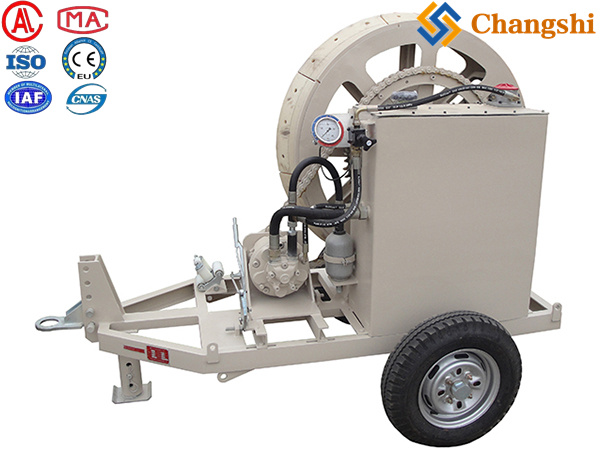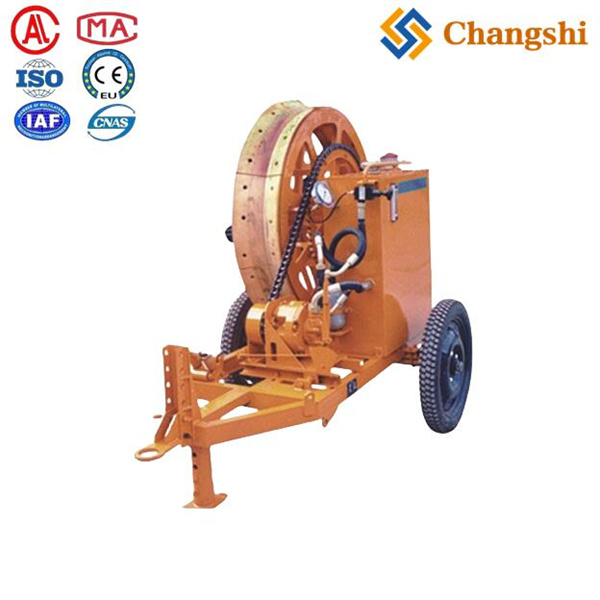
Single Bullwheel Tensioners for Wire & Cable
Single bullwheel tensioners are a foundational piece of equipment in the stringing of overhead wire and cable, serving a wide range of applications from smaller distribution lines to single-conductor segments of large transmission projects, and especially for delicate fiber optic cables.
What is a Single Bullwheel Tensioner?
A single bullwheel tensioner, at its core, is a machine designed to apply a controlled, constant braking force to a single wire or cable as it is unspooled from a reel. This prevents the wire/cable from sagging to the ground, touching obstacles, or being damaged during the stringing process.
Key characteristics:
Bullwheel Mechanism: It features a set of one or two large, grooved bullwheels (often paired side-by-side) around which the wire or cable is wrapped multiple times. The friction created by these wraps, combined with a hydraulic braking system, precisely controls the payout tension.
Hydraulic Braking: The bullwheels are connected to a hydraulic circuit that generates the necessary resistance. This hydraulic system allows for highly accurate and infinitely variable tension control.
Dedicated for Single Lines: As the name suggests, it's designed to tension one single conductor, pilot rope, or cable at a time.
Integrated Reel Stands (Common): Many single bullwheel tensioners come with an integrated hydraulic reel winder or reel carrier. This allows the operator to load and unload the cable reel directly onto the tensioner, ensuring a smooth and controlled payout of the wire or cable.
Control Panel: Operators use a control panel with gauges (like dynamometers for real-time tension readings) and controls to set and monitor the desired tension. Modern units often have automatic tensioning systems for greater precision.
Safety Features: Includes automatic braking mechanisms (e.g., negative self-acting hydraulic brakes) that engage if power is lost or tension limits are exceeded, ensuring the cable doesn't free-spool.
Applications for Single Bullwheel Tensioners:
While multi-bullwheel tensioners are for bundled transmission conductors, single bullwheel units have a broad range of uses:
Distribution Line Stringing: This is a very common application. For installing new or replacing existing single-phase or multi-phase distribution lines (typically 12.47 kV, 22.8 kV, 34.5 kV, etc.) on poles.
Pilot Rope Stringing: Even for large EHV/UHV transmission lines with bundled conductors, a single, lighter pilot rope is always pulled first across the spans. A single bullwheel tensioner is used to apply tension to this pilot rope to prevent it from sagging too much and to control its installation. This pilot rope is then used to pull in the heavier conductors or bundles.
OPGW (Optical Ground Wire) and ADSS (All-Dielectric Self-Supporting) Cable Installation: These are often single, delicate fiber optic cables that require very precise and controlled tensioning to prevent damage to the optical fibers. Single bullwheel tensioners are ideal for this due to their precision and gentle handling capabilities. Many are specifically designed for fiber optic cable with appropriate groove lining.
Single-Conductor Transmission Lines: While less common for new EHV/UHV, some transmission lines still utilize a single large conductor per phase. Single bullwheel tensioners with higher capacities would be used for these applications.
Reconductoring Single Lines: Replacing an old single conductor with a new one. The tensioner precisely controls the payout of the new conductor.
Underground Cable Pulling (Specific Cases): While multi-drum pullers are more common for heavy underground cables, lighter, single underground cables might be tensioned using a single bullwheel unit, especially if they need to be kept under tension during payout into a duct.


